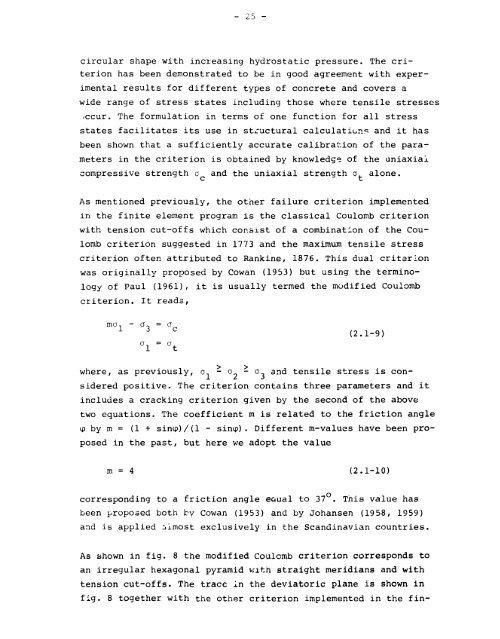Nonlinear Finite Element Analysis of Concrete Structures
Nonlinear Finite Element Analysis of Concrete Structures
Nonlinear Finite Element Analysis of Concrete Structures
You also want an ePaper? Increase the reach of your titles
YUMPU automatically turns print PDFs into web optimized ePapers that Google loves.
iL _><br />
_<br />
circular shape with increasing hydrostatic pressure. The criterion<br />
has been demonstrated to be in good agreement with experimental<br />
results for different types <strong>of</strong> concrete and covers a<br />
wide range <strong>of</strong> stress states including those where tensile stresses<br />
iccur. The formulation in terms <strong>of</strong> one function for all stress<br />
states facilitates its use in structural calculations and it has<br />
been shown that a sufficiently accurate calibration <strong>of</strong> the parameters<br />
in the criterion is obtained by knowledge <strong>of</strong> the uniaxial<br />
compressive strength c and the uniaxial strength a alone.<br />
As mentioned previously, the other failure criterion implemented<br />
in the finite element program is the classical Coulomb criterion<br />
with tension cut-<strong>of</strong>fs which consist <strong>of</strong> a combination <strong>of</strong> the Coulomb<br />
criterion suggested in 1773 and the maximum tensile stress<br />
criterion <strong>of</strong>ten attributed to Rankine, 1876. This dual criterion<br />
was originally proposed by Cowan (1953) but using the terminology<br />
<strong>of</strong> Paul (1961), it is usually termed the modified Coulomb<br />
criterion. It reads,<br />
ma, - o~. = o<br />
6 C<br />
°1 = °t<br />
(2.1-9)<br />
where, as previously, a, - o - o and tensile stress is considered<br />
positive. The criterion contains three parameters and it<br />
includes a cracking criterion given by the second <strong>of</strong> the above<br />
two equations. The coefficient m is related to the friction angle<br />
ip by m = (1 + sinip)/(l - sinip) . Different m-values have been proposed<br />
in the past, but here we adopt the value<br />
m = 4 (2.1-10)<br />
corresponding to a friction angle eoual to 37 . This value has<br />
been proposed both by Cowan (1953) and by Johansen (1958, 1959)<br />
and is applied almost exclusively in the Scandinavian countries.<br />
As shown in fig. 8 the modified Coulomb criterion corresponds to<br />
an irregular hexagonal pyramid with straight meridians and with<br />
tension cut-<strong>of</strong>fs. The trace in the deviatoric plane is shown in<br />
fig. 8 together with the other criterion implemented in the fin-
















